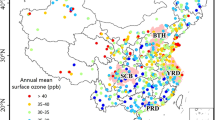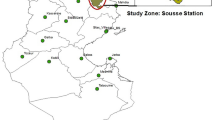Abstract
This study uses a deep learning approach to forecast ozone concentrations over Seoul, South Korea for 2017. We use a deep convolutional neural network (CNN). We apply this method to predict the hourly ozone concentration on each day for the entire year using several predictors from the previous day, including the wind fields, temperature, relative humidity, pressure, and precipitation, along with in situ ozone and NO2 concentrations. We refer to a history of all observed parameters between 2014 and 2016 for training the predictive models. Model-measurement comparisons for the 25 monitoring sites for the year 2017 report average indices of agreement (IOA) of 0.84–0.89 and a Pearson correlation coefficient of 0.74–0.81, indicating reasonable performance for the CNN forecasting model. Although the CNN model successfully captures daily trends as well as yearly high and low variations of the ozone concentrations, it notably underpredicts high ozone peaks during the summer. The forecasting results are generally more accurate for the stations located in the southern regions of the Han River, the result of more stable topographical and meteorological conditions. Furthermore, through two separate daytime and nighttime forecasts, we find that the monthly IOA of the CNN model is 0.05–0.30 higher during the daytime, resulting from the unavailability of some of the input parameters during the nighttime. While the CNN model can predict the next 24 h of ozone concentrations within less than a minute, we identify several limitations of deep learning models for real-time air quality forecasting for further improvement.








Similar content being viewed by others
References
Jenkin ME, Clemitshaw KC (2000) Ozone and other secondary photochemical pollutants: chemical processes governing their formation in the planetary boundary layer. Atmos Environ 34(16):2499–2527
Jerrett M, Burnett RT, Pope CA III, Ito K, Thurston G, Krewski D et al (2009) Long-term ozone exposure and mortality. N Engl J Med 360(11):1085–1095
McKeen S, Wilczak J, Grell G, Djalalova I, Peckham S, Hsie EY et al (2005) Assessment of an ensemble of seven real-time ozone forecasts over eastern North America during the summer of 2004. J Geophys Res 110(D21):D21307
McHenry JN, Ryan WF, Seaman NL, Coats CJ Jr, Pudykiewicz J, Arunachalam S, Vukovich JM (2004) A real-time Eulerian photochemical model forecast system: overview and initial ozone forecast performance in the northeast US corridor. B Am Meteorol Soc 85(4):525–548
Zhang Y, Bocquet M, Mallet V, Seigneur C, Baklanov A (2012) Real-time air quality forecasting, part I: history, techniques, and current status. Atmos Environ 60:632–655
Zhang Y, Bocquet M, Mallet V, Seigneur C, Baklanov A (2012) Real-time air quality forecasting, part II: state of the science, current research needs, and future prospects. Atmos Environ 60:656–676
Byun D, Schere KL (2006) Review of the governing equations, computational algorithms, and other components of the models-3 community multiscale air quality (CMAQ) modeling system. Appl Mech Rev 59:51–77
Slini T, Karatzas K, Moussiopoulos N (2001) Statistical analysis of environmental data as the basis of forecasting: an air quality application. Sci Total Environ 288:227–237
Choi Y (2014) The impact of satellite-adjusted NOx emissions on simulated NOx and O3 discrepancies in the urban and outflow areas of the Pacific and Lower Middle US. Atmos Chem Phys 14(2):675–690
Pan S, Choi Y, Roy A, Jeon W (2017) Allocating emissions to 4 km and 1 km horizontal spatial resolutions and its impact on simulated NOx and O3 in Houston, TX. Atmos Environ 164:398–415
Pan S, Choi Y, Jeon W, Roy A, Westenbarger DA, Kim HC (2017) Impact of high-resolution sea surface temperature, emission spikes and wind on simulated surface ozone in Houston, Texas during a high ozone episode. Atmos Environ 152:362–376
Durão RM, Mendes MT, Pereira MJ (2016) Forecasting O3 levels in industrial area surroundings up to 24 h in advance, combining classification trees and MLP models. Atmos Pollut Res 7:961–970
Sun W, Palazoglu A, Singh A, Zhang H, Wang Q, Zhao Z, Cao D (2015) Prediction of surface ozone episodes using clusters based generalized linear mixed effects models in Houston–Galveston–Brazoria area, Texas. Atmos Pollut Res 6:245–253
Siwek K, Osowski S (2016) Data mining methods for prediction of air pollution. Int J Appl Math Comput Sci 26:467–478
Wang D, Wei S, Luo H, Yue C, Grunder O (2017) A novel hybrid model for air quality index forecasting based on two-phase decomposition technique and modified extreme learning machine. Sci Total Environ 580:719–733
Pandey G, Zhang B, Jian L (2013) Predicting submicron air pollution indicators: a machine learning approach. Environ Sci Process Impacts 15(5):996–1005
Williams DRGHR, Hinton GE (1986) Learning representations by back-propagating errors. Nature 323:533–538
Kuremoto T, Kimura S, Kobayashi K, Obayashi M (2014) Time series forecasting using a deep belief network with restricted Boltzmann machines. Neurocomputing 137:47–56
Kumar A, Goyal P (2013) Forecasting of air quality index in Delhi using neural network based on principal component analysis. Pure Appl Geophys 170:711–722
Feng X, Li Q, Zhu Y, Hou J, Jin L, Wang J (2015) Artificial neural networks forecasting of PM25 pollution using air mass trajectory based geographic model and wavelet transformation. Atmos Environ 107:118–128
Peng H, Lima AR, Teakles A, Jin J, Cannon AJ, Hsieh WW (2016) Evaluating hourly air quality forecasting in Canada with nonlinear updatable machine learning methods. Air Qual Atmos Health 10:195–211
Hecht-Nielsen R (1988) Theory of the backpropagation neural network. Neural Netw 1:445–448
Panchal G, Ganatra A, Kosta YP, Panchal D (2011) Behaviour analysis of multilayer perceptrons with multiple hidden neurons and hidden layers. Int J Comput Sci Eng 3:333–337
Bengio Y, Lamblin P, Popovici D, Larochelle H (2007) Greedy layer-wise training of deep networks. Adv Neural Inform Process Syst 19:153–160
Hinton GE, Osindero S, Teh YW (2006) A fast learning algorithm for deep belief nets. Neural Comput 18:1527–1554
Hinton GE, Salakhutdinov RR (2006) Reducing the dimensionality of data with neural networks. Science 313:504–507
Bengio Y (2009) Learning deep architectures for AI. Found Trend Mach Learn 2:1–127
Zhang CY, Chen CP, Chen D, Ng KT (2016) MapReduce based distributed learning algorithm for restricted Boltzmann machine. Neurocomputing 198:4–11
Zhang CY, Chen CP, Gan M, Chen L (2015) Predictive deep Boltzmann machine for multiperiod wind speed forecasting. IEEE Trans Sustain Energy 6:1416–1425
Deng L, Yu D (2014) Deep learning: methods and applications. Found Trend Signal Process 7:197–387
Schmidhuber J (2015) Deep learning in neural networks: an overview. Neural Netw 61:85–117
LeCun Y, Bengio Y, Hinton GE (2015) Deep learning. Nature 521:436–444
Hrasko R, Pacheco AG, Krohling RA (2015) Time series prediction using restricted boltzmann machines and backpropagation. Procedia Comput Sci 55:990–999
Cai X, Hu S, Lin X (2012) Feature extraction using restricted Boltzmann machine for stock price prediction. In: Proceedings of IEEE international conference computer science and automation engineering (CSAE), Zhangjiajie, China, vol 3, pp 80–83
Li H, Hou J, Adhikari B, Lyu Q, Cheng J (2017) Deep learning methods for protein torsion angle prediction. BMC Bioinform 18:417
Li X, Peng L, Hu Y, Shao J, Chi T (2016) Deep learning architecture for air quality predictions. Environ Sci Pollut Res 23:22408–22417
Li X, Peng L, Yao X, Cui S, Hu Y, You C, Chi T (2017) Long short-term memory neural network for air pollutant concentration predictions: method development and evaluation. Environ Pollut 231:997–1004
Li T, Shen H, Yuan Q, Zhang X, Zhang L (2017) Estimating ground-level PM25 by fusing satellite and station observations: a geo-intelligent deep learning approach. Geophys Res Lett 44(23):11985–11993
Krizhevsky A, Sutskever I, Hinton GE (2012) Imagenet classification with deep convolutional neural networks. Proc Adv Neural Inf Process Syst 25:1090–1098
Hu W, Huang Y, Wei L, Zhang F, Li H (2015) Deep convolutional neural networks for hyperspectral image classification. J Sens 2015:1–12
Jeon WB, Lee SH, Lee H, Park C, Kim DH, Park SY (2014) A study on high ozone formation mechanism associated with change of NOx/VOCs ratio at a rural area in the Korean Peninsula. Atmos Environ 89:10–21
Jeon WB, Lee SH, Lee HW, Kim HG (2012) Process analysis of the impact of atmospheric recirculation on consecutive high-O3 episodes over the Seoul Metropolitan Area in the Korean Peninsula. Atmos Environ 63:213–222
Bengio Y, LeCun Y (2007) Scaling learning algorithms towards AI. In: Bottou L, Chapelle O, DeCoste D, Weston J (eds) Large scale kernel machines. MIT Press, Cambridge, pp 321–360
Bengio Y, Simard P, Frasconi P (1994) Learning long-term dependencies with gradient descent is difficult. IEEE Trans Neural Netw 5:157–166
Gu J, Wang Z, Kuen J, Ma L, Shahroudy A, Shuai B et al (2018) Recent advances in convolutional neural networks. Pattern Recogn 77:354–377
Nogueira K, Penatti OA, dos Santos JA (2017) Towards better exploiting convolutional neural networks for remote sensing scene classification. Pattern Recogn 61:539–556
Kim Y (2014) Convolutional neural networks for sentence classification. arXiv preprint. arXiv:14085882
Lawrence S, Giles CL, Tsoi AC, Back AD (1997) Face recognition: a convolutional neural-network approach. IEEE Trans Neural Netw 8(1):98–113
Russakovsky O, Deng J, Su H, Krause J, Satheesh S, Ma S et al (2015) Imagenet large scale visual recognition challenge. Int J Comput Vision 115(3):211–252
Simonyan K, Zisserman A (2014) Very deep convolutional networks for large-scale image recognition. arXiv preprint arXiv:14091556
Sun Yi, Wang X, Tang X (2013) Deep convolutional network cascade for facial point detection. In: Proceedings of the IEEE conference on computer vision and pattern recognition, pp 3476–3483
Belagiannis V, Rupprecht C, Carneiro G, Navab N (2015) Robust optimization for deep regression. In Proceedings of the IEEE international conference on computer vision, pp 2830–2838
LeCun Y, Bengio Y (1995) Convolutional networks for images, speech, and time series. Handb Brain Theory Neural Netw 3361(10):1
Hinton GE (2014) What’s wrong with convolutional nets? MIT brain and cognitive sciences—fall colloquium series. URL http://www.techtvmitedu/collections/bcs/videos/30698-what-s-wrong-with-convolutional-nets. Accessed 10 Feb 2017
Chollet F (2015) Keras. https://www.kerasio
Abadi M, Barham P, Chen J, Chen Z, Davis A, Dean J, Devin M et al (2016) Tensor flow: a system for large-scale machine learning. OSDI 16:265–283
Mazumder R, Hastie T, Tibshirani R (2010) Spectral regularization algorithms for learning large incomplete matrices. J Mach Learn Res 11:2287–2322
Willmott CJ (1981) On the validation of models. Phys Geogr 2(2):184–194
Kingma DP, Ba J (2014) Adam: a method for stochastic optimization. arXiv preprint. arXiv:1412.6980
Chen XW, Lin X (2014) Big data deep learning: challenges and perspectives. IEEE Access 2:514–525
Bengio Y, Courville A, Vincent P (2013) Representation learning: a review and new perspectives. IEEE Trans Pattern Anal Mach Intell 35:1798–1828
Acknowledgements
This study was supported by funding from the Department of Earth and Atmospheric Science (EAS Research Grant) of the University of Houston and the National Institute of Environmental Research (NIER).
Author information
Authors and Affiliations
Corresponding author
Ethics declarations
Conflict of interest
The authors declare that they have no conflict of interest.
Additional information
Publisher's Note
Springer Nature remains neutral with regard to jurisdictional claims in published maps and institutional affiliations.
Electronic supplementary material
Below is the link to the electronic supplementary material.
Rights and permissions
About this article
Cite this article
Eslami, E., Choi, Y., Lops, Y. et al. A real-time hourly ozone prediction system using deep convolutional neural network. Neural Comput & Applic 32, 8783–8797 (2020). https://doi.org/10.1007/s00521-019-04282-x
Received:
Accepted:
Published:
Issue Date:
DOI: https://doi.org/10.1007/s00521-019-04282-x




